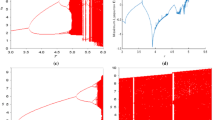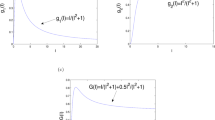Abstract
The presence of infectious diseases can dramatically change the dynamics of ecological systems. By studying an SI-type disease in the predator population of a Rosenzweig–MacArthur model, we find a wealth of complex dynamics that do not exist in the absence of the disease. Numerical solutions indicate the existence of saddle–node and subcritical Hopf bifurcations, turning points and branching in periodic solutions, and a period-doubling cascade into chaos. This means that there are regions of bistability, in which the disease can have both a stabilising and destabilising effect. We also find tristability, which involves an endemic torus (or limit cycle), an endemic equilibrium and a disease-free limit cycle. The endemic torus seems to disappear via a homoclinic orbit. Notably, some of these dynamics occur when the basic reproduction number is less than one, and endemic situations would not be expected at all. The multistable regimes render the eco-epidemic system very sensitive to perturbations and facilitate a number of regime shifts, some of which we find to be irreversible.








Similar content being viewed by others
References
Bate, A. M., & Hilker, F. M. (2013). Predator–prey oscillations can shift when diseases become endemic. J. Theor. Biol., 316, 1–8.
Beardmore, I., & White, K. A. J. (2001). Spreading disease through social groupings in competition. J. Theor. Biol., 212, 253–269.
Begon, M., Bennett, M., Bowers, R. G., French, S. M., Hazel, N. P., & Turner, J. (2002). A classification of transmission terns in host-microparasite models: numbers, densities and areas. Epidemiol. Infect., 129, 147–153.
Berezovskaya, F. S., Song, B., & Castillo-Chavez, C. (2010). Role of prey dispersal and refuges on predator–prey dynamics. SIAM J. Appl. Math., 70, 1821–1839.
Berryman, A. A., & Millstein, J. A. (1989). Are ecological systems chaotic—and if not, why not? Trends Ecol. Evol., 4, 26–28.
Biggs, R., Carpenter, S. R., & Brock, W. A. (2009). Turning back from the brink: detecting an impending regime shift in time to avert it. Proc. Natl. Acad. Sci. USA, 106, 826–831.
Chattopadhyay, J., & Bairagi, N. (2001). Pelicans at risk in Salton Sea—an eco-epidemiological model. Ecol. Model., 136, 103–112.
Ferrari, M. J., Perkins, S. E., Pomeroy, L. W., & Bjørnstad, O. N. (2011). Pathogens, social networks, and the paradox of transmission scaling. Interdiscip. Perspect. Infect. Dis., 2011, 267049.
Gilpin, M. E. (1979). Spiral chaos in a predator–prey model. Am. Nat., 113, 306–308.
González-Olivares, E., & Rojas-Palma, A. (2011). Multiple limit cycles in a Gause type predator–prey model with Holling type III functional response and Allee effect on prey. Bull. Math. Biol., 73, 1378–1397.
Hastings, A., & Powell, T. (1991). Chaos in a three-species food chain. Ecology, 72, 896–903.
Hilker, F. M., & Malchow, H. (2006). Strange periodic attractors in prey–predator system with infected prey. Math. Popul. Stud., 13, 119–134.
Hilker, F. M., & Schmitz, K. (2008). Disease-induced stabilization of predator–prey oscillations. J. Theor. Biol., 225, 299–306.
Hilker, F. M., Langlais, M., & Malchow, H. (2009). The Allee effect and infectious diseases: extinction, multistability, and the (dis-)appearance of oscillations. Am. Nat., 173, 72–88.
Hurtado, P. J., Hall, S. R., & Ellner, S. P. (2013). Infectious disease in consumer populations: dynamic consequences of resource-mediated transmission and infectiousness, manuscript in review.
Kooi, B. W., van Voorn, G. A. K., & Das, K. p. (2011). Stabilization and complex dynamics in a predator–prey model with predator suffering from an infectious disease. Ecol. Complex., 8, 113–122.
Kuznetsov, Y. A. (1995). Elements of applied bifurcation theory. New York: Springer.
May, R. (1974). Biological populations with nonoverlapping generations: stable points, stable cycles, and chaos. Science, 186, 645–647.
McCallum, H., Barlow, N., & Hone, J. (2001). How should pathogen transmission be modelled? Trends Ecol. Evol., 16, 295–300.
Rosenzweig, M. L., & MacArthur, R. H. (1963). Graphical representation and stability conditions of predator–prey interactions. Am. Nat., 97, 209–223.
Scheffer, M. (2009). Critical transitions in nature and society. Princeton: Princeton University Press.
Seydel, R. (1988). From equilibrium to chaos—practical bifurcation and stability analysis. New York: Elsevier.
Sieber, M., & Hilker, F. M. (2011). Prey, predators, parasites: intraguild predation or simpler community modules in disguise? J. Anim. Ecol., 80, 414–421.
Siekmann, I., Malchow, H., & Venturino, E. (2010). On competition of predators and prey infection. Ecol. Complex., 7, 446–457.
Stiefs, D., Venturino, E., & Feudel, U. (2009). Evidence of chaos in eco-epidemic model. Math. Biosci. Eng., 6, 855–871.
Thomas, W. R., Pomerantz, M. J., & Gilpin, M. E. (1980). Chaos, asymmetric growth and group selection for dynamical stability. Ecology, 61, 1312–1320.
Upadhyay, R. K., Bairagi, N., Kundu, K., & Chattopadhyay, J. (2008). Chaos in eco-epidemiological problem of the Salton Sea and its possible control. Appl. Math. Comput., 196, 392–401.
van den Driessche, P., & Watmough, J. (2002). Reproductive numbers and sub-threshold endemic equilibria for compartmental models of disease transmission. Math. Biosci., 180, 29–48.
Acknowledgements
The authors would like to thank Faina Berezovsky and an anonymous reviewer for their constructive comments.
Author information
Authors and Affiliations
Corresponding author
Appendix: Steady States of FD and DD Models
Appendix: Steady States of FD and DD Models
There are two key differences between the DD and FD model. One is the existence of a disease-induced extinction of the predator in the FD model. The other is that there can be only one coexistent steady state in the FD model as the corresponding value of i ∗ is known; whereas in the DD model, there can be one or two coexistent steady states.
1.1 A.1 Trivial/Semi-trivial Steady States
-
Both models: (0,0,0) which always exists and is always unstable.
-
Both models: (1,0,0) which always exists and is stable if \(m>\frac{1}{1+h}\), unstable otherwise.
-
Both models: (N ∗,P ∗,0), where \(N^{*}=\frac{hm}{1-m}\) and P ∗=r(h+N ∗)(1−N ∗). This exists when \(m<\frac{1}{1+h}\) (<1). It is stable if \(N^{*}>\frac{1-h}{2}\) (equivalently \(m>\frac{1-h}{1+h}\) (Hopf bifurcation)) and \(R_{0}^{*}<1\), where \(R_{0}^{*}\) equals \(\frac{\beta P^{*}}{m+\mu}\) (DD model) and \(\frac{\beta}{m+\mu}\) (FD model).
-
FD model only: (1,0,i ∗) where \(i^{*}=1-\frac{1}{(\beta-\mu )(1+h)}\). This exists when \(\beta-\mu>\frac{1}{1+h}\) and is stable if \(m+\mu i^{*}>\frac{1}{1+h}\), unstable otherwise.
-
(FD model only: (0,0,1). This is always unstable.)
-
(FD model only: (0,0,i ∗). i ∗ is unspecified. This only exists when β=μ, which is not generally true. This is always unstable.)
1.2 A.2 Coexistent Steady State(s)
1.2.1 A.2.1 DD Model
The coexistent equilibria for the DD model are of the form (N ∗,P ∗,i ∗), where \(N^{*}=\frac{h(m+\mu i^{*})}{1-(m+\mu i^{*})}\), P ∗=r(h+N ∗)(1−N ∗) and \(i^{*}=1-\frac{N^{*}}{h+N^{*}}\frac{1}{\beta P^{*}-\mu }=1-\frac{m+\mu i^{*}}{\beta P^{*}-\mu}=\frac{\mu(1-i^{*})-m+\beta P^{*}}{\beta P^{*}-\mu}\). This exists when \(i^{*}<\frac{1-m}{\mu}\) (N ∗>0), \(i^{*}<\frac{1}{\mu(h+1)}-\frac{m}{\mu}\) (N ∗<1, i.e. P ∗>0), \(P^{*}>\frac{\mu}{\beta}\) (for i ∗<1) and \(P^{*}>\frac{\mu+m}{\beta}\) (for i ∗>0).
The strongest of these conditions are \(i^{*}<\frac{1}{\mu(h+1)}-\frac {m}{\mu}\) and \(P^{*}>\frac{\mu+m}{\beta}\), which are the conditions that \(R^{p}_{i}>1\) (the predators’ reproductive number given an infection is present) and \(R_{0}^{*}>1\), (the diseases’ reproductive number).
It is not clear whether (N ∗,P ∗,i ∗) has only one solution. Consequently, this must be solved. For tidiness, let D=m+μi ∗. Starting with \(\frac{D-m}{\mu}\) (=i ∗), we get:
After some further rearrangement, we get:
This is clearly quadratic with respect to D, and thus i ∗. D can only be biologically realistic if D∈(m,m+μ) (i.e. i ∗∈(0,1)). This means there are at most two feasible coexistent solutions.
The stability is not fully investigated. However, when these steady states exist, no other steady state is stable. Also, when there are two viable coexistent steady states, they will be connected to a nearby saddle–node bifurcation, so only one steady state should be stable. Given this, we expect would that either one of the coexistent equilibria is stable or there is some stable periodic solution.
1.2.2 A.2.2 FD Model
The coexistent steady state for the FD model is (N ∗,P ∗,i ∗) where \(N^{*}=\frac{h(m+\mu i^{*})}{1-(m+\mu i^{*})}\), P ∗=r(h+N ∗)(1−N ∗) and \(i^{*}=1-\frac{\mu+m}{\beta}\). This exists when β>μ+m (i ∗>0), \(i^{*}<\frac{1-m}{\mu}\) (N ∗>0), \(i^{*}<\frac {1}{\mu(h+1)}-\frac{m}{\mu}\) (N ∗<1, i.e. P ∗>0). Like the DD model, the two strongest conditions are \(i^{*}<\frac{1}{\mu(h+1)}-\frac {m}{\mu}\) and β>μ+m. In this case, there is only one coexistent steady state if it exists.
The stability is not fully investigated. However, when this steady state exists, no other steady state is stable. Given this, we would expect that either one of the coexistent equilibria is stable or there is some stable periodic solution.
Rights and permissions
About this article
Cite this article
Bate, A.M., Hilker, F.M. Complex Dynamics in an Eco-epidemiological Model. Bull Math Biol 75, 2059–2078 (2013). https://doi.org/10.1007/s11538-013-9880-z
Received:
Accepted:
Published:
Issue Date:
DOI: https://doi.org/10.1007/s11538-013-9880-z




